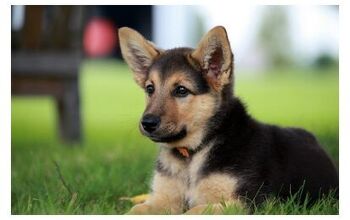Is Catnip Bad for Dogs?

Have you recently noticed your dog sniffing around your cat’s favorite toy? If so, you may find yourself wondering why your dog is drawn to something clearly designed for cats. After all, it’s called “cat” nip for a reason, right?
This harmless-looking herb drives our cats into a frenzy of rolling, drooling, and playful craziness. But what happens if your dog ingests the leafy green? Does it cause the same “high”? Is it even safe? And, perhaps most importantly, could the herb that’s famous for making cats go wild actually offer any potential benefits for our pups? After all, we want to give our dogs the happiest lives possible, and that sometimes means exploring options outside of the usual dog-specific products.
In this article, I’ll answer these questions and more.
What Exactly is Catnip?
You’ve likely seen catnip mentioned a million times when it comes to cats’ toys, but what exactly is it? To understand how it interacts with your dog, we first need to know exactly what it is. It’s much more than just a novelty for the kitties in our lives; it’s an herb with a long history, even in human tradition.
Catnip, scientifically known as Nepeta cataria, is a perennial herb in the mint family. It’s native to parts of Europe, Asia, and the Middle East, but it now grows readily around the world. In fact, you can likely buy catnip seeds in your local garden center. Historically, long before it was known for entertaining housecats, humans used it in herbal teas for its calming and mild sedative properties. It was also sometimes used to improve digestion.
The reason catnip attracts so much attention centers on one specific volatile oil: Nepetalactone. This oil is contained within the leaves, stems, and seed pods of the plant.
In cats, it’s the nepetalactone that triggers the short-term neurological reaction that we see, aka the crazy burst of energy that they get when they get near it. However, as I’ll explain in the next section, the canine system processes the chemical very differently. It’s unlikely to start zooming around the room after a sniff.
Is Catnip Safe for Dogs?
Returning to the original question of this article, is catnip safe for your dog? If your pup decides to tear apart a cat toy (as my girl Willow has done several times), should you be worried?
When discussing the safety of any substance, we need to address both the potential for toxicity and the risk of discomfort for your pup. While the latter may not be life-threatening, we all want to take steps to keep our dogs feeling comfortable!
Catnip is Generally Non-Toxic to Dogs
First and foremost, you can breathe a sigh of relief if your dog has recently tested the waters with the herb. According to organizations like the ASPCA and the Pet Poison Helpline, catnip is not listed as a poisonous substance that can cause severe or life-threatening reactions in dogs. If your dog nibbles a stray leaf or manages to sample the dried herb while chewing a cat toy, there is no need to panic. The plant will not poison them.
Understanding “Non-Toxic” vs. “Harmless”
While catnip isn’t poisonous, that doesn’t mean your dog should be allowed to eat a whole patch. It’s crucial that dog parents understand the difference between a substance being “non-toxic” (aka not poisonous) and “harmless” or safe to eat without any consequences.
The risk associated with catnip exposure centers almost entirely on gastrointestinal problems. The digestive systems of our dogs are not designed to ingest large quantities of plant matter. If they eat too much of any herb or green, including catnip, it can irritate their digestive tract.
The most common side effects of eating excessive amounts of plant matter are mild and short-lived, such as temporary vomiting, diarrhea, or general stomach discomfort. Generally, your dog will start to feel better as soon as the material passes. However, if your dog passes the plants and is still showing signs of discomfort, contact your veterinarian, as there may be a bigger problem to address.
The Hidden Hazard of the Toy Itself
Now that we’ve clarified that eating some catnip from chewing a cat toy isn’t going to cause any serious harm, there is a danger associated with this situation that I want to highlight. Chewing a non-edible item (like a cat toy) can lead to trouble!
Catnip toys are designed to be light, fluffy, and enticing for cats. But they are not durable for a powerful canine jaw, especially if your pup is a power chewer like our two! If they ingest a chunk of stuffing, the fabric or plastic pieces, or even a whole catnip mouse (yes, it happens), it can create a serious choking hazard or, worse, a risk of life-threatening obstruction.
Always supervise your dog around cat toys if they share their home with a feline sibling. Immediately take away the toys if you see your pup starting to chew on them.
The Impact of Catnip on Dogs
We’re all familiar with the hilarious, erratic behavior you might see from your cat after being exposed to catnip, but what about dogs? If your pup does manage to ingest a little catnip, you may be surprised. The key difference lies in the way dogs and cats process the active ingredient, nepetalactone.
Unlike cats, dogs don’t get “high” on catnip. Cats possess specialized receptors, particularly in the roof of their mouth, that are sensitive to nepetalactone. This triggers a strong, euphoric response when the scent is inhaled, leading to the reaction we commonly associate with the herb.
On the other hand (or paw), dogs lack these sensitive receptors. While they can smell the herb, their brains do not process the nepetalactone in a way that causes the typical stimulation. Instead, they respond when they ingest catnip (either the leaves or the dried herb). For our pups, this acts as a mild sedative or relaxant. It is the same effect that humans expect when they historically brewed catnip tea to calm their nerves or help them sleep.
When consumed, catnip has a mild depressant effect on a dog’s central nervous system, helping to reduce general restlessness or anxiety. The response is often very subtle, so don’t expect your dog to suddenly collapse into a tranquil slumber. Instead, you can expect your pup to show a slight easing of tension or an increase in general calmness.
While rare, it is worth noting that a very small percentage of dogs may experience the opposite, showing a mild stimulating effect. Always monitor your dog carefully during their first few exposures to see how their unique system processes the herb. If you notice increased agitation or hyperactivity, stop using it.
However, for the vast majority of dogs, the primary effect is either a mild calming one or none at all.
Potential Benefits of Catnip for Dogs
Given that catnip is generally safe and often offers a mild calming effect on dogs, many pet parents wonder if it can be used to improve their dog’s quality of life. The answer is yes! But the benefits are typically modest and geared toward minor, situational concerns.
Focus on Mild Anxiety and Stress Relief
The primary reason to introduce catnip to your dog is to help ease mild anxiety or general restlessness. It can be helpful in scenarios that trigger minor, temporary stress, such as short car rides, visits to the groomer, or mild reactions to far-off fireworks next holiday. For dogs who struggle to settle down at night or are prone to excessive pacing, a small, safe dose of catnip might help them relax and rest.
However, it is crucial to understand that catnip is NOT a cure or treatment for severe anxiety, noise phobias, or serious behavioral issues. If your dog exhibits destructive behavior, panic attacks, or persistent fear, they will need a greater level of support than this herb can offer. Contact a veterinary behaviorist or your veterinarian to discuss your options.
Use as a Digestive Aid
Historically, catnip was valued in herbalism for its ability to soothe the digestive tract. The herb is a mild carminative, meaning it can help relieve gas discomfort or flatulence. For dogs prone to mild stomach upset (perhaps from eating something non-toxic that upsets their stomach or stress-related nausea), catnip may help calm the stomach lining.
Note on Safety: This use must be approached carefully and always with the knowledge that too much catnip can have the opposite effect, causing digestive upset. The focus here is on a very small, therapeutic amount. If you are new to this use of catnip, consider asking your veterinarian for guidance on the correct dosage.
Enrichment and Distraction
Beyond the physical benefits, catnip can also be used as a tool for mental stimulation and fun, which is a very important consideration when it comes to giving your dog the best possible quality of life. Introducing a new scent or flavor into their daily routine in a safe way provides enrichment and helps to break up monotony, keeping your dog’s brain engaged. You can also use a small sprinkle of catnip to encourage interest in a new chew toy, a snuffle mat, or a puzzle feeder that your dog hasn’t been showing any interest in.
Repellent Properties
While less common, there are some unique repellent benefits associated with catnip that may help improve your pup’s life. Nepetalactone is known to be a natural mosquito repellent. While a large concentration is needed for it to be effective, making it unlikely that topical use will work, many pet parents use catnip in their gardens to help deter certain instincts and keep the yard pest-free for them and their pets, without the need for chemical pesticides.
Safely Giving Catnip to Your Dog
If you’ve decided to explore catnip as a way to help your pup with relaxation and enrichment, moderation is the most important point to remember. Providing the best possible care means approaching any new supplement or product responsibly.
Chat with Your Vet
The single most important step before introducing any new herb or supplement, catnip included, is to have a conversation with your veterinarian. They can advise you on any potential interactions if your dog is already taking prescription medications (especially those for anxiety or seizures). They can also confirm if your dog has any underlying issues or sensitivities that may make even a small amount of the herb risky. Sometimes, the risks outweigh the benefits.
Dosage and Forms
When giving your dog catnip, start with the absolute minimum dose and use only high-quality, pure forms. You can always increase the dosage slowly until you see the benefits you’re looking for. Some common forms of catnip include:
- Dried Herb: The safest and most common form is the dried leaves and flowers of the pure herb. Look for organic, culinary-grade catnip to ensure it is top quality and avoids contaminants.
- Tea Form: You can brew a very weak tea by steeping a small amount of the herb in hot water, allowing it to cool completely, and mixing a tiny splash into your dog’s water bowl or food. Do not use commercial teas, as they may contain harmful sweeteners like xylitol.
- Calming Toys: Another way to introduce the scent of catnip for calming purposes is through catnip toys specifically designed for dogs. They docs on delivering the scent of the herb safely while also considering the durability needs of a dog toy. Sniffing and licking the toy can engage your dog’s senses, serve as a form of enrichment, and promote a mild sense of relaxation in stressful settings. We love the Doggijuana line of toys in our house!
Avoid Oils and Concentrates
The essential oil form of catnip is highly potent and should generally be avoided unless specifically directed by a holistic or veterinary professional. Potent oils can be difficult to dose, may irritate your pup’s skin or nasal passages, and can even cause severe side effects.
Monitoring and Storage
Whether you're giving the herb orally or offering a specialized toy, it’s important to always prioritize proper storage and monitor your pup carefully. Keep all dried catnip and catnip-laced toys stored securely out of reach of your cats and dogs. This prevents accidental ingestion of large amounts and eliminates the risk of them tearing apart and swallowing toy components. This is definitely a case of it’s better to be safe than sorry!
After the first small dose or introduction of a new catnip-based toy, observe your dog closely for a full day. Look for the desired effect (mild relaxation) but also watch for negative signs like vomiting, diarrhea, or lethargy.
Integrating Catnip Safely into Your Dog’s Routine
Catnip is non-toxic for pups, but it should be handled responsibly to keep your best friend safe. While your dog won’t experience the euphoric “high” of a cat, small, safe doses of the herb or purpose-built toys may offer a mild calming effect, helping to soothe situational anxiety or restlessness. The key is moderation and safety: always consult with your vet before starting any new supplement and monitor your dog closely. By making informed, thoughtful choices about new introductions, you may find some great benefits for your dog.
Join the PetGuide community. Get the latest pet news and product recommendations by subscribing to our newsletter here.

Britt Kascjak is a proud pet mom, sharing her heart (and her home) with her “pack” which includes her husband John, their 2 dogs – Lucifer and Willow – and their 3 cats – Pippen, Jinx, and Theia. She has been active in the animal rescue community for over 15 years, volunteering, fostering and advocating for organizations across Canada and the US. In her free time, she enjoys traveling around the country camping, hiking, and canoeing with her pets.
More by Britt
























